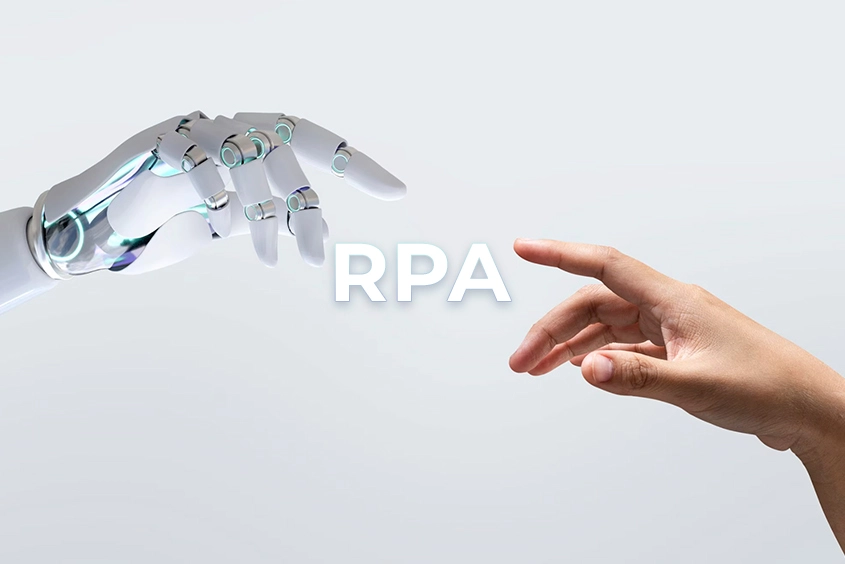In the healthcare industry, claims processing is a complex task that involves managing vast amounts of data, endless verification, and ensuring compliance with regulations. As healthcare systems become more intricate and clients become more expectant of faster service, the demand for efficient and accurate claims processing solutions has surged.
To address these challenges, insurance companies are increasingly adopting Robotic Process Automation (RPA) and Machine Learning (ML). These technologies are transforming how insurers handle claims by automating repetitive tasks, improving data accuracy, and enabling faster decision-making. This article will explain how RPA and ML are revolutionizing claims processing and how a healthcare company can benefit from implementing these solutions into day-to-day operations.

The major flaw in the traditional manual claims processing model is us—humans.
Manual processing is plagued with challenges that lead to inefficiencies and higher costs. Moreover, compliance with the ever-more complicated healthcare regulations and increasing cases of sophisticated fraudulent claims requires constant vigilance.
The company can make a choice to solely rely on its employees, but statistics show that usually this results in an increased rate of errors, which consequently leads to delayed claims approval and customer dissatisfaction. As the volume of claims grows, these manual processes struggle to scale, causing bottlenecks, further exacerbating delays and errors, and eventually leading to hampered cash flow.
Finally, manual processing is simply more expensive. Significant human labor requirements drive up operational costs, while human judgment cannot be trusted in detecting fraud and managing fragmented data. This fragmentation makes it difficult to consolidate information, identify fraud patterns, and gain insights that could enhance decision-making and risk management.
As a result, insurers are increasingly looking toward automation solutions to overcome these obstacles.
Transitioning to Insurance Claims Automation: Changes Are Painful and Will Take Time
Despite the willingness to automate, many insurance companies still struggle with the transition. There are the usual prospects, such as:
-
Hesitancy among staff to abandon manual claims
-
Budget constraints to improve existing systems
-
Lack of technical resources to implement automation systems
Insurance processes are usually complex and unstructured. Claims data come in various formats, including: photos, voice memos, and handwritten documents. Additionally, these files are also shared across various channels: email, phone calls, document attachments, and chats. This makes it challenging to translate into a digital workflow and translates to unstructured data.
Because everything is so segmented, it is difficult to accurately analyze these without an agent’s supervision. When it comes to claims processing, context is also very important. As such, it can be challenging for artificial intelligence to make decisions on its own.
So what’s the solution?
The key is a more advanced approach using and combining the following technologies:
-
Robotic Process Automation (RPA)
-
Artificial Intelligence
-
Machine Learning (ML)
-
ML-Based RPA
How Does RPA Work?
Robotic process automation (RPA) involves the use of software that handles repetitive and rule-based tasks. This requires the claim handler to enter data, fill in the same information many times, and copy-paste it. Organizations that regularly handle large amounts of data can free up manpower time with RPA.
RPA works by accessing existing information from IT systems. In short, RPA tools integrate with applications. This can be done through backend connections to databases and enterprise web services. Or via front-end or desktop connections.
Insurance companies can leverage RPA for automated claims processing. They can train data to develop a risk assessment tool. This way, claimants can understand how their claims are interpreted. Data can also be used to develop tools to help consumers.
For example, a tool to help assess market planning options can compare claims prices and payment methods. Damage assessment can also be automated with image analysis.
AI and RPA can simplify the underwriting process and do away with surveys and lengthy questions. The result is a more agile workflow to help companies handle claims quickly.
How Can RPA and ML Be Used in Insurance Claims Automation?
RPA and ML can reduce companies' time processing insurance applications. Besides efficient broker communications, RPA and ML can help streamline claim filing updates. Also, they can help to ensure that policyholders renew their policies on time.
RPA plays a crucial role in streamlining the lifecycle of an insurance claim. Here's how:
Streamlines Vendor Onboarding
RPA automates transactional processes and manages claims distribution. This can be especially helpful when dealing with multiple vendors. Some key areas of claims processing that can be streamlined with RPA are:
-
Accounting
-
Analysis
-
Dues settlement
-
Credit risk assessment
-
Tax and regulatory compliance
-
Administrative tasks
Claim Verification, Underwriting, and Pricing Reviews
Besides verifying the claims, RPA can also assist in analyzing credit profiles and assessing risk levels for specific claims. This process covers gathering customer data, income verification, and reviewing payment histories. These allow companies to offer the best deals to clients and accurately price their policies.
Stores and Manages Customer Data
RPA tools also streamline the collection and storage of customer data. By automating such a process, agents can easily access information. RPA helps to categorize unstructured data, which otherwise goes unprocessed.
Ensures Legal and Regulatory Compliance
The insurance industry operates under stringent legal frameworks. Thus, insurers need to adhere to regulatory standards to remain compliant. RPA facilitates regular audits, ensuring that documentation is accurate and data is verified.
How Do You Automate Claims Processing with RPA?
RPA captures customer-specific data. It allows companies to generate detailed reports when assessing customers’ claims. RPA also helps pinpoint process issues by examining suppliers’ payment flows.
Suppliers struggling with their current claims management can also implement a claims processing automation and risk management system. Self-assessment tools with integrated processes for claims automation may help automate the tracking of claim statuses.
Current image recognition technology is also useful for the initial stages of claims automation. As machines continue to train on data, software for claims processing can settle claims and address fraud cases.
Needless to say, the use of RPA and ML in insurance calls for the integration of not just software but also skills and insights. With better collaboration to improve the claims process, insurers can provide customers with a better experience.
Benefits of Using AI-Powered RPA in Claims Processing
 RPA offers several advantages in claims processing. First, automated insurance claims handling does away with the need for human intervention. This accelerates transaction speed. It also ensures high-quality data management and allows inspectors to address issues in claims filing.
RPA offers several advantages in claims processing. First, automated insurance claims handling does away with the need for human intervention. This accelerates transaction speed. It also ensures high-quality data management and allows inspectors to address issues in claims filing.
Here are some other benefits of AI-enhanced RPA in claims processing:
Cost Savings
Implementing AI-enhanced RPA in claims processing leads to significant cost savings for insurance companies. By automating routine and repetitive tasks, insurers can reduce the need for large, labor-intensive teams, cutting down on operational expenses. Additionally, automated systems minimize the errors and rework often associated with manual processing, further reducing costs. Over time, these savings can be reinvested into other areas of the business, such as enhancing customer service or developing new products.
Seamless Data Extraction
An advanced RPA system facilitates the automatic extraction of various data formats from relevant documents. Encoders often struggle with diverse structures and formats. RPA simplifies this by recognizing visual layouts, labeling data, and entering it into claims processing systems.
Faster Turnaround Times
RPA reduces data redundancy and duplicate entries. This leads to faster turnaround times in invoice processing. It also automates data entry and end-to-end claims processing. This improves customer satisfaction with quicker claim application processing time and faster claim settlement.
Improved Customer Experience
AI-powered RPA significantly enhances the customer experience by speeding up the claims process and reducing the likelihood of errors. Customers can receive faster responses to their claims, leading to greater satisfaction and loyalty. Automated systems consistently provide accurate information and can offer personalized services, which helps build trust and loyalty with clients.
Better Client Recruitment and Loyalty
RPA solutions streamline recruitment processes by simplifying customer profile scanning. RPA can perform thorough reviews and audits of insurance applications, reducing company risk. This also improves customer relationship management, screening, and assessments.
Fraud Detection
One of the most critical advantages of AI-enhanced RPA is its ability to detect fraudulent claims more effectively than manual handlers. By analyzing large datasets and identifying patterns that may indicate insurance fraud, these systems can flag suspicious claims for further investigation. Machine learning algorithms can continuously improve their fraud detection capabilities by learning from past data, enabling insurers to stay ahead of increasingly sophisticated fraudulent activities.
Conclusion
As businesses continue to leverage technology for streamlined operations, RPA stands out as a tool for success. Integrating RPA and ML in current claims processes has several benefits. It optimizes operational efficiency and enhances client experience. RPA accelerates processes and reduces risks. To explore how RPA can transform your insurance processes, visit NY BillPro today and discover the potential for your agency.

 0/5 (0 votes)
0/5 (0 votes)
 240 views
240 views



